
Now you can follow ThorntonWeather.com on Twitter. Follow us on the network for all the latest news and conditions updated every half hour. This is a great way to ensure you are always up to date with the latest local conditions for Thornton!
In the United States, the winter is generally considered ‘flu season’ and is when we see it most widespread. With the threat of a potential swine flu epidemic, analysts are trying to determine if the weather will play any factor in the spread of the virus.
The flu is spread through contact with an infected person or pig, typically through coughing or sneezing. In the winter, when most people in temperate regions like the United States are spending time indoors in closed environments and in close quarters with those that are infected, it is thought that the flu can be transmitted easier. The water droplets containing the virus are slower to evaporate in cooler weather thus remaining airborne for longer periods of time and increasing chances of others becoming infected.
Outbreaks can and do occur in the tropics however research indicates they occur with less frequency in places that do not have the seasonality that other areas do. Limited laboratory and health data from regions like Africa and Latin America have made it more difficult to track the spread of viruses and thus learn from it.
The World Meteorological Organization (WMO) said on Monday that it hoped drier and warmer weather would help stifle the effects of the swine flu. The organization is asking health authorities to work with weather services to assess the role of weather and the climate in the outbreak as this is an aspect that is not fully known. WMO spokeswoman Gaelle Sevenier said , “The transmission patterns of this particular influenza and its possible seasonality are as yet not adequately understood and are the subject of ongoing investigations.”
| For all the details, read the rest of this story on our Denver Weather Examiner page. |  |
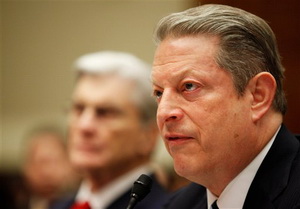
As legislators in Washington D.C. debated a climate change bill that would levy new taxes on businesses and potentially cost consumers, political theatre was in full view Friday at the House of Representatives. The House Energy and Commerce Committee held hearings all last week on the legislation, culminating with the appearance of former Vice President Al Gore and former Speaker of the House and potential 2012 presidential candidate Newt Gingrich.
Democrats who support the measure and the ‘cap and trade tax’ it would bring, brought forth the self-appointed head of the global warming movement Al Gore. Mr. Gore of course was full of his usual dire predictions of the Earth’s pending doom from carbon dioxide accumulation in the atmosphere unless immediate action is taken. He likened those who doubted the theory to those who don’t believe man landed on the moon saying, “There are people who still believe that the moon landing was staged on a movie lot in Arizona.”
Perhaps Mr. Gore wasn’t aware but even some of those that have been to the moon and walked on its surface don’t believe all the hype about global warming. It was just recently that a real moonwalker announced his doubts about the theory as well. Dr. Harrison Schmitt, an Apollo 17 astronaut, moonwalker, and PhD holding geologist said, “Contrary to categorical statements by many politicians and unfortunately some scientists, including some colleagues of mine, the science of climate change and its causes is not settled – at least not to this geologist.”
There is much more to this story – including battles between the committee and Newt Gingrich when he appeared. Learn more about how politics have taken over the debate on manmade climate change in the full story on Examiner.com.
| For all the details, read the rest of this story on our Denver Weather Examiner page. |  |

This week in Denver weather history shows the extremely wide variety of conditions we can have this year. From major snow storms to hail dropping thunderstorms, we can see it all.
From the National Weather Service:
24-26
IN 1924…POST-FRONTAL RAIN CHANGED TO SNOW…WHICH BECAME HEAVY AND TOTALED 10.2 INCHES OVER DOWNTOWN DENVER. THE GREATEST AMOUNT OF SNOW ON THE GROUND WAS 6.0 INCHES ON THE 25TH DUE TO MELTING. NORTH WINDS WERE SUSTAINED TO 38 MPH WITH GUSTS TO 42 MPH ON THE 24TH.
25-26
IN 1985…A SPRING STORM BROUGHT MUCH RAIN AND SNOW TO METRO DENVER. THE FOOTHILLS WERE BURIED WITH 15 INCHES OF SNOW AT CONIFER AND 12 INCHES AT EVERGREEN. AT LOWER ELEVATIONS… AN INCH OR MORE OF RAIN FELL IN DENVER AND BOULDER. THE HEAVY PRECIPITATION CAUSED BRIEF POWER OUTAGES IN THE DENVER AREA. PRECIPITATION TOTALED 1.06 INCHES AT STAPLETON INTERNATIONAL AIRPORT…INCLUDING ONLY 0.7 INCH OF SNOWFALL.
25-27
IN 1877…SNOW ENDED AROUND 7:00 AM ON THE MORNING OF THE 27TH… AFTER FALLING CONTINUOUSLY FOR 48 HOURS AND TOTALING AN ESTIMATED 13 INCHES IN THE CITY. THE STORM…LIKELY ACCOMPANIED BY STRONG WINDS…CAUSED TRAINS TO BE DELAYED FOR 2 TO 3 DAYS. ONE OR TWO ROOFS OF SMALL BUILDINGS WERE CRUSHED BY THE WEIGHT OF THE SNOW…AND MANY TREE BRANCHES WERE BROKEN IN THE CITY. THERE WERE A NUMBER OF REPORTS OF LIVESTOCK LOSSES. ONE STOCKMAN LOST 17 HORSES AND SEVERAL CATTLE FROM THE SNOW AND COLD. PRECIPITATION TOTALED 1.30 INCHES FROM THE STORM.
26
IN 1965…WHILE ONLY 0.40 INCH OF RAIN FELL AT STAPLETON INTERNATIONAL AIRPORT…SOME COMMUNITIES IN THE FOOTHILLS WEST OF DENVER REPORTED OVER 30 INCHES OF SNOW FROM THE STORM.
IN 1972…A SPRING SNOW STORM ACCOMPANIED BY THUNDER DUMPED 15.8 INCHES OF HEAVY WET SNOW ON METRO DENVER. STRONG NORTHWEST WINDS GUSTING TO 35 MPH PRODUCED BLOWING SNOW. THE STORM WAS QUITE INTENSE AND GREATLY HAMPERED TRAVEL. HIGH WINDS CAUSED DRIFTS 10 TO 15 FEET DEEP IN SOME AREAS… BLOCKING ROADS AND STRANDING HUNDREDS OF MOTORISTS. AN ESTIMATED 500 TO 600 PEOPLE WERE STRANDED IN THE CASTLE ROCK AREA. RESCUE SERVICE WAS PROVIDED BY HEAVY ARMY EQUIPMENT FROM FORT CARSON. POWER LINES WERE DOWNED…POWER POLES WERE TOPPLED…AND A NUMBER OF STEEL TOWERS CARRYING HIGH VOLTAGE POWER LINES WERE DOWNED. SOME AREAS NORTHEAST OF DENVER WERE WITHOUT POWER FOR A WEEK. A LARGE NUMBER OF CATTLE AND SHEEP WERE KILLED BY THE STORM. THE GREATEST SNOW DEPTH ON THE GROUND AT STAPLETON INTERNATIONAL AIRPORT WAS 12 INCHES. WARM TEMPERATURES FOLLOWING THE STORM QUICKLY MELTED THE SNOW.
IN 1995…THE THIRD MAJOR SNOW STORM OF THE MONTH DUMPED HEAVY SNOW IN AND NEAR THE FRONT RANGE FOOTHILLS. SIX TO 12 INCHES OF HEAVY WET SNOW FELL IN THE WESTERN METRO SUBURBS WITH THE HEAVIEST AMOUNTS ABOVE 6 THOUSAND FEET. BOTH BOULDER AND GOLDEN MEASURED 10 INCHES OF SNOW. ONLY 2.4 INCHES OF SNOWFALL WERE MEASURED AT THE SITE OF THE FORMER STAPLETON INTERNATIONAL AIRPORT. NORTH WINDS GUSTED 28 MPH AT DENVER INTERNATIONAL AIRPORT.
IN 1998…THE LAST IN A SERIES OF APRIL STORMS BLANKETED THE FOOTHILLS WITH HEAVY SNOW. SNOWFALL AMOUNTS INCLUDED: 17 INCHES NEAR BLACKHAWK…15 INCHES AT IDAHO SPRINGS…14 INCHES AT GEORGETOWN…11 INCHES NEAR CONIFER AND MORRISON. ONLY A TRACE OF SNOW FELL AT THE SITE OF THE FORMER STAPLETON INTERNATIONAL AIRPORT. NORTH WINDS GUSTED TO 28 MPH AT DENVER INTERNATIONAL AIRPORT.
Continue reading April 26 to May 2 – This week in Denver weather history
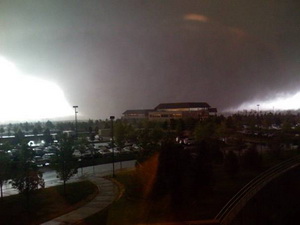
As is customary, the governor has declared this week Severe Weather Awareness Week. This is an opportunity for the public to get reacquanted with the dangers severe weather presents in Colorado.
Tornadoes, lightning, hail, severe wind and flooding are very real hazards that Coloradoans face every year during severe weather season. It is important that you know what to do to protect you and your family.
In conjunction with the National Weather Service, Examiner.com will be publishing our Severe Weather 101 series. Each day this week a weather hazard will be discussed in depth and we will outline protective measures you can take to keep yourself and your family safe. Please be sure to check back every day to read these important message.
From the National Weather Service:
Thunderstorm hazards around the corner…are you prepared?
Severe thunderstorm season will be soon upon us. Do you know how to stay safe around tornadoes, flash floods, lightning, hail, and damaging winds? This is the week to learn. This week, April 19th to 25th, is Colorado severe weather awareness week. This is the time to learn more about severe weather in Colorado, develop severe weather preparedness plans, and test vital communications.
Can we learn lessons from the past severe weather events? Just last year on may 22nd an EF3 tornado raced north through Weld and Larimer counties resulting in one fatality. Several injuries and destroyed or heavily damaged hundreds of homes. Two years ago, on March 28, 2007 the town of Holly was heavily damaged by another EF3 tornado that resulted in two fatalities. Twelve years ago on July 28, 1997 a devastating flash flood occurred in Fort Collins resulting in 5 fatalities and millions of dollars in damage.
Each year for the past 20 years there have been an average of 50 tornadoes in Colorado, 3 people killed by lightning and another 15 injured by lightning.
The National Weather Service offices which cover Colorado will issue a series of public information statements during the week covering the following topics:
A time to test your warning reception and communications systems is planned. Each national weather service office serving Colorado will send test tornado warnings on Tuesday April 21 between the hours of 8 am MDT and 11 am MDT. These test warnings will be sent to the emergency alert system, the internet, NOAA weather radio and law enforcement communications systems.
Safety information, watches, warnings, forecasts, past weather and much more information is available at your local National Weather Service web sites:
www.weather.gov/denver NWS Denver web site
www.weather.gov/pueblo NWS Pueblo web site
www.weather.gov/goodland NWS Goodland web site
www.weather.gov/gjt NWS Grand Junction web site
This is an introduction to a five part series on Colorado’s severe weather.
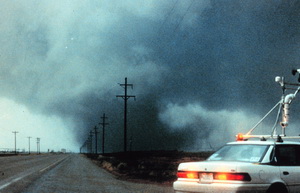
The single largest and most ambitious field study to increase our understanding of tornadoes is set to kick off next month. The Verification of Origin of Rotation in Tornadoes EXperiment2 (VORTEX2 or V2) will feature more than 50 scientists utilizing 40 vehicles, 10 mobile radar units and an Unmanned Aerial Vehicle (UAV).
The study which will run from May 10 to June 13 will become the largest mobile in-field laboratory ever assembled to study tornadoes. In a statement Louis Wicker, research meteorologist with NOAA’s National Severe Storms Laboratory and V2 co-principal investigator said, “Data collected from V2 will help researchers understand how tornadoes form and how the large-scale environment of thunderstorms is related to tornado formation.”

Operations will be controlled at the National Weather Center in Norman, Oklahoma while the mobile units chase tornadoes across Tornado Alley and the central Great Plains. The target area for the study ranges from southern South Dakota through Nebraska, Kansas, Oklahoma and the Texas Panhandle. Eastern Colorado, home of many tornadoes, is included in the study.
This unprecedented gathering of scientists and technology hold incredible promise for the research that will be gathered. The original VORTEX program which happened from 1994 to 1995 documented the entire life cycle of a tornado from start to finish, the first time that had ever been done. That research greatly enhanced our understanding of twisters and led to much improved tornado warnings that help to save lives today.
VORTEX2 seeks to build on that research and the research that has taken place since. According to the project website it will seek to answer such important questions as: How do tornadoes form? What exactly causes the wind to spin into a concentrated funnel? How can we tell exactly when a tornado will form and when it will die, or how long it will last? Why do some thunderstorms produce tornadoes and others do not? What is the structure of tornadoes? What is the relationship of tornadic winds to damage?
An important finding from the original VORTEX experiment was that the factors responsible for causing tornadoes happen on smaller time and space scales than scientists had thought. New advances will allow for a more detailed sampling of a storm’s wind, temperature and moisture environment and lead to a better understanding of why tornadoes form – and how they can be more accurately predicted.
– Stephan Nelson, NSF program director for physical and dynamic meteorology.
VORTEX2 features scientists and students from the United States, Canada and Australia in collaboration with government agencies, private industry and educational institutions. Many luminaries within the storm chasing and severe weather research community will participate including Dr. Josh Wurman of the Discovery Channel’s Storm Chasers TV show. Some of the notable participating organizations include Center for Severe Weather Research, Rasmussen Systems, NOAA National Severe Storms Laboratory, OU/NOAA Cooperative Institute for Mesoscale Meteorological Studies, NSF-sponsored National Centers for Atmospheric Research, Penn State University, University of Oklahoma, Texas Tech University, Lyndon State College, University of Colorado, Purdue University, North Carolina State University, University of Illinois, University of Massachusetts, University of Nebraska, Environment Canada, and the Australian Bureau of Meteorology.
For more information:
[nggallery id=3]
As we begin to dry out from an incredibly wet April storm, we can take a look at some of the numbers from the three day event. Being on the warmer east side of the Denver area, Thornton did not receive a tremendous amount of snow as temperatures here simply remained too warm. What we did get though was rain – and LOTS of it.
ThorntonWeather.com measured 3.06 inches of precipitation – the most we have recorded for a single weather event since we went operational in October 2006. Friday was the wettest of the three days with 1.86 inches recorded – not a single day record for ThorntonWeather.com but still a great amount for our arid climate. The steady and more or less constant rain brought much needed moisture and helps to make up for what has been a dry snow season thus far.
Denver did officially set a record for Friday when 1.16 inches of precipitation was recorded at Denver International Airport – the most ever on April 17th. The old record was 1.00 inch set in 1920.
While we remain well behind normal on snow for the season, for the calendar year thus far, the storm put Denver ahead of the curve on precipitation. Normally by this date we would have had 3.36 inches of precipitation. Since January 1 Denver has now recorded 3.61 inches, 0.25 inch above normal, so that is definitely good news.
As we mentioned, Thornton did not receive a lot of snow from this event. We recorded 3.1 inches total as the rain / snow mix we saw at many times resulted in what snow did fall being compacted by rain immediately thereafter. Other areas of the Front Range however, those primarily west and south, were a touch colder and received a great deal of snow. A quick look at a few of the snow totals from the event:
All of that moisture and a coming week of temperatures in the 70’s are sure to truly start greening up the landscape. It won’t be long now for sure and you will be mowing the lawn!

This week in Denver weather history is one to truly showcase the incredible variety of weather Colorado can receive. Major snow storms, high winds, warm temperatures in the 80’s and even three reports of tornadoes – one near Thornton 21 years ago – have all been seen this time of year.
17-19
IN 1920…SNOW FELL ACROSS THE CITY CONTINUOUSLY FOR 57 HOURS… FROM THE EARLY MORNING OF THE 17TH UNTIL 11:40 AM ON THE 19TH. THE HEAVY WET SNOWFALL TOTALED 18.2 INCHES WITH THE GREATEST ACCUMULATION ON THE GROUND OF 12 INCHES. WINDS DURING THE STORM WERE STRONG WITH SUSTAINED SPEEDS IN EXCESS OF 27 MPH FOR OVER 40 CONSECUTIVE HOURS…WHICH CREATED NEAR-BLIZZARD CONDITIONS. THE HIGHEST RECORDED WIND SPEEDS WERE 44 MPH WITH GUSTS TO 50 MPH FROM THE NORTH ON THE 17TH AND 39 MPH WITH GUSTS TO 48 MPH FROM THE NORTHWEST ON THE 18TH. THE STRONG WINDS PILED THE SNOW INTO HIGH DRIFTS WHICH STOPPED ALL DENVER TRAFFIC. RAILROADS WERE BLOCKED WITH ONLY ONE TRAIN ENTERING THE CITY ON THE 19TH. ALL INTERURBAN TRAINS WERE BLOCKED…AS WERE THE 13 TROLLEY LINES. THUS…MANY WORKERS WERE UNABLE TO GET HOME AT NIGHT AND FILLED ALL OF THE DOWNTOWN HOTELS TO CAPACITY. NO GROCERY OR FUEL DELIVERIES WERE POSSIBLE… EXCEPT MILK AND COAL TO HOSPITALS AND TO FAMILIES WITH BABIES. NO LIVES WERE LOST IN THE CITY…BUT SEVERAL PEOPLE PERISHED IN SURROUNDING DISTRICTS. STOCK LOSSES WERE HEAVY ON THE PLAINS. TEMPERATURES DURING THE STORM WERE IN THE 20’S.
18-19
IN 1884…A MAJOR STORM DUMPED 13.8 INCHES OF SNOWFALL ON DOWNTOWN DENVER. MOST OF THE SNOW…10.0 INCHES…FELL ON THE 18TH. LIGHT RAIN ON THE EARLY MORNING OF THE 18TH CHANGED TO HEAVY SNOW AT 8:00 AM AND BECAME LIGHT AFTER 2:00 PM BUT CONTINUED UNTIL 4:00 AM ON THE 19TH. THE SNOW MELTED NEARLY AS FAST AS IT FELL. THERE WERE ONLY 3 INCHES ON THE GROUND EARLY ON THE MORNING OF THE 19TH.
IN 1941…HEAVY SNOWFALL TOTALED 8.4 INCHES OVER DOWNTOWN DENVER. NORTHEAST WINDS WERE SUSTAINED TO 17 MPH.
IN 1993…SPORADIC HIGH WINDS OCCURRED ACROSS METRO DENVER. SIGNIFICANT WIND GUSTS INCLUDED 97 MPH AT ROLLINSVILLE… 80 MPH IN SOUTHWEST BOULDER…AND 55 MPH AT STAPLETON INTERNATIONAL AIRPORT. THE STRONG WINDS SNAPPED A PINE TREE TOP…ABOUT 15 FEET LONG AND 8 INCHES IN DIAMETER…WHICH CRASHED THROUGH THE ROOF OF A CHURCH IN EVERGREEN…CAUSING ONE THOUSAND DOLLARS IN DAMAGE. WIND GUSTS OF 50 TO 60 MPH CAUSED STRUCTURAL DAMAGE TO 3 HOMES UNDER CONSTRUCTION IN BROOMFIELD. NORTHWEST WINDS GUSTED TO 55 MPH AT STAPLETON INTERNATIONAL AIRPORT.
IN 1995…THE SECOND SPRING STORM OF THE MONTH DUMPED HEAVY SNOW IN THE FOOTHILLS. THE UPSLOPE FLOW ALONG WITH AREAS OF THUNDER SNOW DROPPED 6 TO 12 INCHES OF SNOW IN THE FOOTHILLS WEST OF DENVER AND BOULDER. SNOWFALL TOTALED 4.6 INCHES AT THE SITE OF THE FORMER STAPLETON INTERNATIONAL AIRPORT…BUT MOST OF THE SNOW MELTED AS IT FELL. EAST WINDS GUSTED TO 29 MPH AT DENVER INTERNATIONAL AIRPORT ON THE 18TH.
Continue reading April 19 to April 25 – This week in Denver weather history
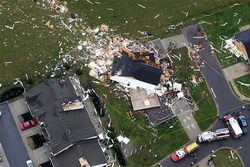
The severe weather season has started in earnest now and last week’s deaths of five people from tornadoes highlight the danger this time of year brings. Thus far however, 2009 is below the three year average not only in the total number of tornadoes reported but also in the number of tornado related deaths.
In terms of the number of tornado reports, through yesterday there have been 303 preliminary reports in 2009. Over the last three years the United States has averaged 391 per year through April 13th. That means that 2009 is thus far 23% below average.
|
Tornado Reports by Year
Through April 13th |
||||
|
2009
|
2008
|
2007
|
2006
|
3yr Avg
|
|
303
|
494
|
286
|
392
|
391
|
It is important to note that all of those counts are based on preliminary tornado reports. The actual number of tornadoes that occurred typically is reduced by about 15 percent as duplicate reports are eliminated. Nevertheless, this does show 2009 is running well below average.
In terms of fatalities caused by twisters, there have been 14 thus far this year. This too is below the three year average of 54 per year through April 13th. That is a large 75% reduction which is notable and something certainly to be thankful for.
|
Tornado Fatalities by Year
Through April 13th |
||||
|
2009
|
2008
|
2007
|
2006
|
3yr Avg
|
|
14
|
70
|
52
|
50
|
57
|
It is important to note that while this year shows promise for being a less deadly and less destructive tornado season, the season is far from over. May and June are typically the most active months of the season and one large outbreak could radically change these numbers.
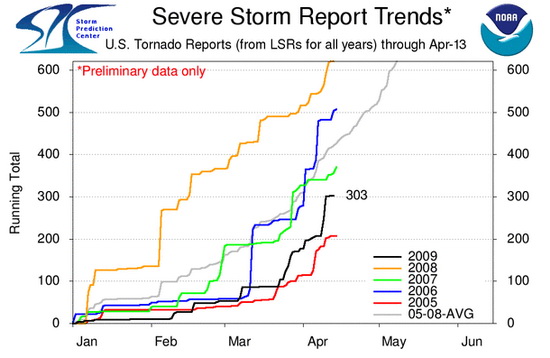

A look back at this week in Denver weather history shows quite the variety of weather conditions. We have seen everything from high winds and snowstorms to hail, thunderstorms and sub-freezing temperatures.
From the National Weather Service:
7-12
IN 1959…SNOW FALLING OVER A 5-DAY PERIOD TOTALED 20 TO 30 INCHES JUST EAST OF THE MOUNTAINS…WHILE OVER THE PLAINS BLIZZARD CONDITIONS CLOSED SCHOOLS AND BLOCKED HIGHWAYS. THE SECOND BIG STORM IN TWO WEEKS DUMPED 16.4 INCHES OF SNOWFALL ON STAPLETON AIRPORT WITH THE MOST…11.6 INCHES… OCCURRING ON THE 8TH. EAST WINDS GUSTED TO 37 MPH ON THE 9TH. TEMPERATURES DIPPED INTO THE SINGLE DIGITS ON THE MORNINGS OF THE 7TH AND 12TH WHEN 7 DEGREES WERE REGISTERED. LOW TEMPERATURE RECORDS FOR THE DATES WERE SET ON THE 9TH…10TH… AND 12TH. THE COLD TEMPERATURES CAUSED STREETS TO GLAZE WITH ICE…RESULTING IN THE DEATH OF A PEDESTRIAN WHO WAS STRUCK BY A CAR IN DENVER. THREE PEOPLE DIED FROM HEART ATTACKS WHILE SHOVELING THE HEAVY… WET SNOW.
9-12
IN 1901…RAIN CHANGED TO SNOW AND TOTALED 10.8 INCHES IN DOWNTOWN DENVER OVER THE 4 DAYS. NORTHEAST WINDS WERE SUSTAINED TO 28 MPH WITH GUSTS TO 31 MPH ON THE 11TH. TEMPERATURES HOVERED IN THE 30`S.
10-12
IN 1997…A PACIFIC STORM PRODUCED HEAVY SNOW ON THE 10TH AND THE 11TH IN AND NEAR THE FOOTHILLS WITH 6 TO 8 INCHES AT LOUISVILLE AND TURKEY CREEK CANYON…5 INCHES AT MORRISON… AND ONLY 3.5 INCHES AT THE SITE OF THE FORMER STAPLETON INTERNATIONAL AIRPORT. NORTHEAST WINDS GUSTED TO 24 MPH AT DENVER INTERNATIONAL AIRPORT. THE STORM ALSO BROUGHT UNSEASONABLY COLD WEATHER WITH 5 NEW TEMPERATURE RECORDS EQUALED OR BROKEN. RECORD LOW TEMPERATURES OF 8 AND 6 OCCURRED ON THE 11TH AND 12TH. RECORD LOW MAXIMUM TEMPERATURES OF 20…19…AND 30 OCCURRED ON THE 10TH…11TH… AND 12TH RESPECTIVELY. THIS WAS ALSO ONLY THE SECOND TIME ON RECORD THAT THE TEMPERATURE HAD FAILED TO REACH THE FREEZING MARK FOR 3 CONSECUTIVE DAYS IN APRIL.
Continue reading April 12 to April 18 – This week in Denver weather history